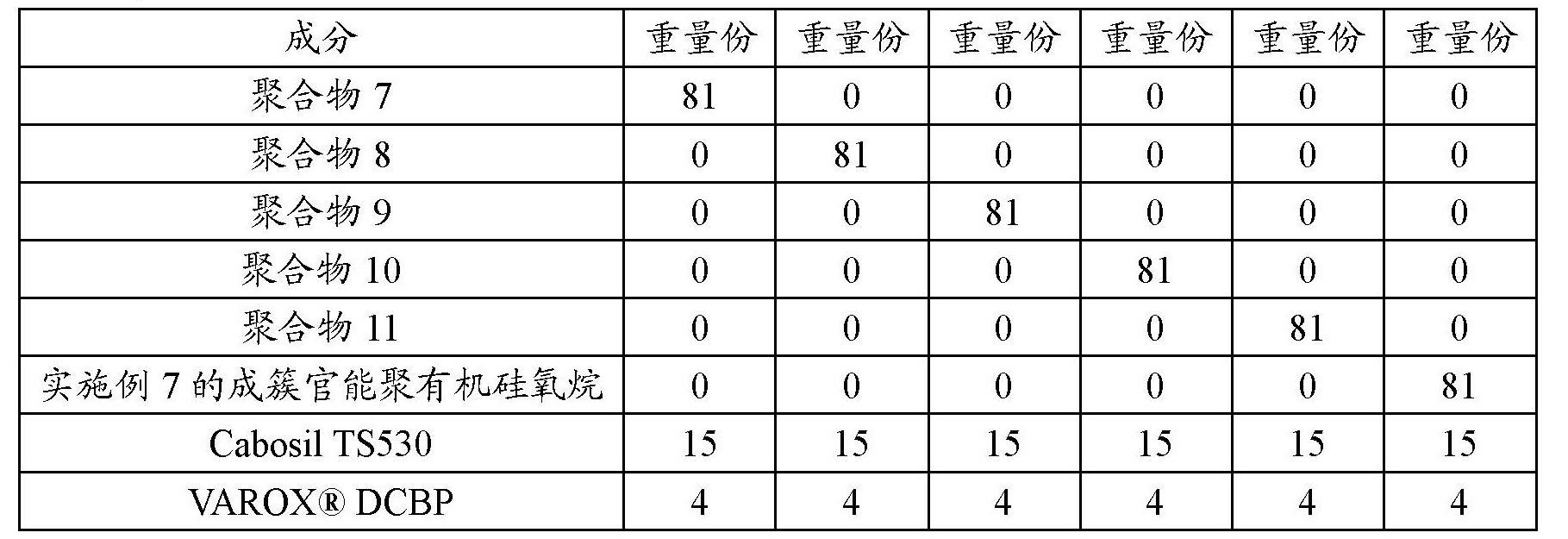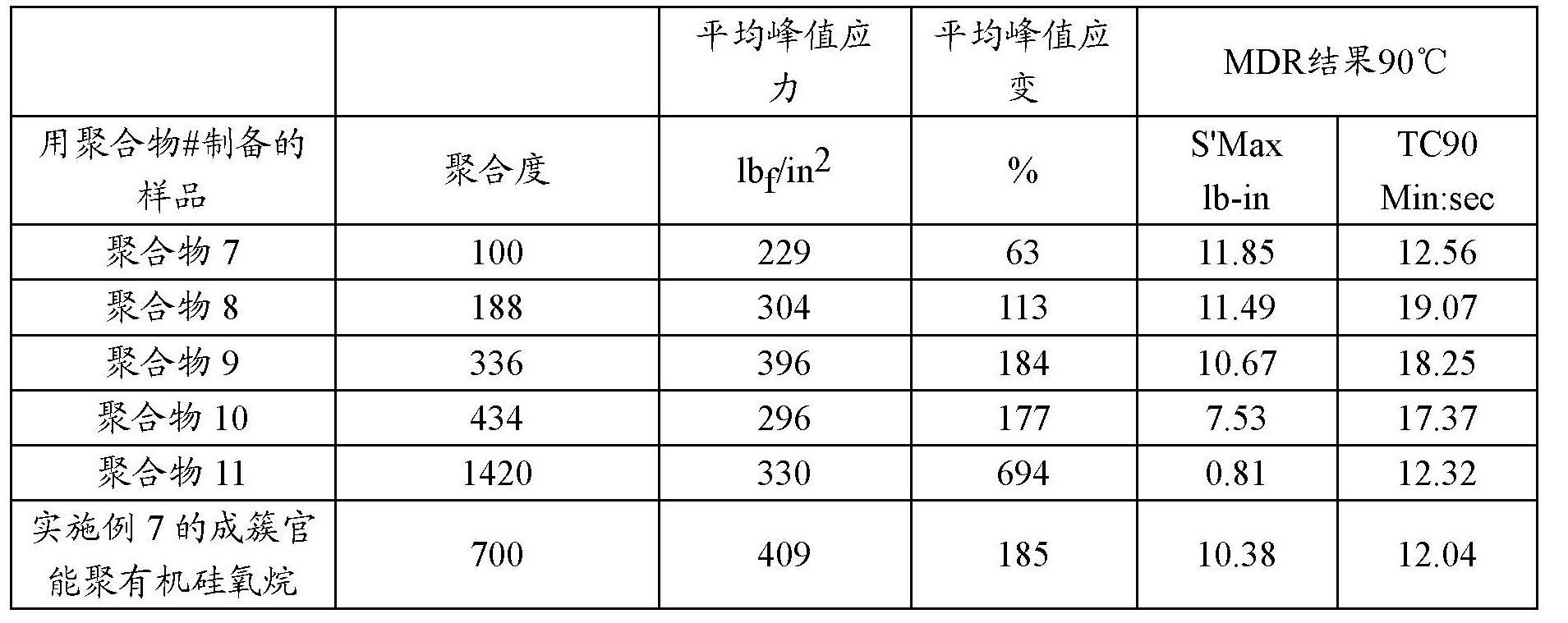Process for preparing clustered functional polyorganosiloxanes, and methods for their use
A technology of polyorganosiloxane and process, which is applied in the preparation process and application field of clustered functional polyorganosiloxane, and can solve the problems of destroying shear thinning performance and damage
- Summary
- Abstract
- Description
- Claims
- Application Information
AI Technical Summary
Problems solved by technology
Method used
Image
Examples
Embodiment
[0211] These examples are intended to illustrate the invention to those of ordinary skill in the art and should not be construed as limiting the scope of the invention set forth in the claims. The following ingredients were used in the following examples.
[0212] Polymer a1) is a 190mm 2 / s viscosity of dimethylvinylsiloxy-terminated polydimethylsiloxane.
[0213] Polymer a2) is a dimethylvinylsiloxy-terminated polydimethylsiloxane having a viscosity of 450 mPa·s.
[0214] Polymer a3) is a dimethylvinylsiloxy-terminated polydimethylsiloxane having a viscosity of 2,000 mPa·s.
[0215] Polymer a4) is a 9,000mm 2 / s viscosity of dimethylvinylsiloxy-terminated polydimethylsiloxane.
[0216] Polymer a5) has a 55,000mm 2 / s viscosity of dimethylvinylsiloxy-terminated polydimethylsiloxane.
[0217] Polymer a6) has a 22,000mm 2 / s viscosity of phenylmethylvinylsiloxy-terminated poly(dimethyl / phenylmethylsiloxane).
[0218] Chain extender g) is a 13mm 2 A hydrogen-terminated ...
Embodiment 1
[0279] In a 1 liter glass resin pot equipped with a condenser, mechanical stirrer and thermocouple, add the following ingredients: 428.34 parts (pt) of polymer a4, 7.65 pt of SIH b2, 14.01 pt of c2) AMA and 0.05 pt of PTZ . The resulting mixture was stirred at room temperature (RT) for 10 min until the mixture was homogeneous. Thereafter, 0.09 pt of Pt catalyst was added, and the mixture was stirred at room temperature for 20 minutes. The reaction was initiated by increasing the mixer temperature to 80°C. By measuring Fourier Transform Infrared Spectroscopy (FT-IR) at 2173cm -1 The reaction was monitored by the decrease of the SiH peak at Typical reaction time is 1 hour. The reaction temperature was then cooled to 50°C, and 0.9 pt of DAM was added with stirring, and the resulting mixture was cooled to room temperature. The resulting clustered functional polyorganosiloxane had a Brookfield cone and plate viscosity of 15300 cps at 5 rpm. For compositions prepared with the ...
Embodiment 2
[0283] In a 10 liter Turrello mixer, 6515 pt of polymer a2), 401 pt of SIH b2), 900 pt of c1) ATMS and 0.89 pt of MEHQ were combined. The combination was stirred for 10 min at RT until the mixture was homogeneous. Thereafter, 1.05 pt of Pt catalyst was added, and the mixture was stirred at room temperature for 20 minutes. The reaction was initiated by increasing the mixer temperature to 100°C. By measuring 2173cm in FT-IR -1 The reaction was monitored by the decrease of the SiH peak at The reaction temperature was then cooled to 50° C., and 8.9 pt of DAM were added with stirring, and the mixture was then cooled to RT. In a dental cup, 95 pts of the resulting moisture cured clustered functional polyorganosiloxane were mixed with 3 pts of IBTMS and 2 parts PITA titanate catalyst. The resulting product had a film tack free time of 2 minutes.
PUM
| Property | Measurement | Unit |
|---|---|---|
| viscosity | aaaaa | aaaaa |
| viscosity | aaaaa | aaaaa |
| tensile properties | aaaaa | aaaaa |
Abstract
Description
Claims
Application Information
 Login to View More
Login to View More - R&D
- Intellectual Property
- Life Sciences
- Materials
- Tech Scout
- Unparalleled Data Quality
- Higher Quality Content
- 60% Fewer Hallucinations
Browse by: Latest US Patents, China's latest patents, Technical Efficacy Thesaurus, Application Domain, Technology Topic, Popular Technical Reports.
© 2025 PatSnap. All rights reserved.Legal|Privacy policy|Modern Slavery Act Transparency Statement|Sitemap|About US| Contact US: help@patsnap.com



